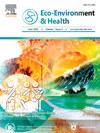Quantitative analysis of PBAT microplastics and their degradation products in soil by mass spectrometry
IF 17.6
引用次数: 0
Abstract
Global production of biodegradable plastics is increasing, but the degradation behavior of microplastics derived from these items in soil is still scarcely reported. In this study, a method for quantifying soil poly(butylene adipate-co-terephthalate) (PBAT) microplastics was developed, and their degradation behavior in three different soils was investigated. PBAT was quantified by analyzing the content of the monomer terephthalic acid (TPA) released during thermally assisted alkali hydrolysis, using liquid chromatography-mass spectrometry (LC-MS). For alkali hydrolysis, the use of capped bottle, water bath (90 °C for 30 min), and ultrasonication (100 kHz for 15 min) allowed for high-throughput sample processing in comparison to the use of round-bottom flask, reflux condenser, and stirring heating mantle. After 150 days, 10.8%–11.0% of PBAT microplastics were degraded in the acidic and neutral soils, while 17.1% were degraded in the alkaline soil, in line with the greatest lipase activity changes in the alkaline soil. This may be due to the fact that alkaline conditions favor initial depolymerization of PBAT, facilitating subsequent microbial attack. PBAT degradation products were also monitored, using solvent extraction combined with LC-MS and gas chromatography-mass spectrometry analysis. It was found that butanediol (up to 1580 μg/kg) accumulated to a higher level than TPA (about 50 μg/kg), especially in acidic and alkaline soils. Overall, this study, for the first time, precisely quantified the degradation of PBAT microplastics in soil. Further study is needed to better understand the fate of biodegradable microplastics in the soil environment and whether they will persist.

质谱法定量分析土壤中PBAT微塑料及其降解产物
可生物降解塑料的全球产量正在增加,但从这些物品中提取的微塑料在土壤中的降解行为仍然很少报道。本研究建立了土壤聚己二酸丁二酯(PBAT)微塑料的定量测定方法,并对其在3种不同土壤中的降解行为进行了研究。采用液相色谱-质谱联用技术(LC-MS)分析热辅助碱水解过程中释放的单体对苯二甲酸(TPA)的含量。对于碱水解,与使用圆底烧瓶,回流冷凝器和搅拌加热罩相比,使用盖瓶,水浴(90°C 30分钟)和超声波(100 kHz 15分钟)允许高通量样品处理。150 d后,PBAT微塑料在酸性和中性土壤中的降解率为10.8% ~ 11.0%,在碱性土壤中的降解率为17.1%,与碱性土壤中脂肪酶活性变化最大一致。这可能是由于碱性条件有利于PBAT的初始解聚,有利于随后的微生物攻击。采用溶剂萃取联用LC-MS和气相色谱-质谱法对PBAT降解产物进行监测。结果表明,丁二醇(1580 μg/kg)的累积量高于TPA (50 μg/kg),特别是在酸性和碱性土壤中。总体而言,本研究首次对PBAT微塑料在土壤中的降解进行了精确量化。需要进一步的研究来更好地了解可生物降解微塑料在土壤环境中的命运以及它们是否会持续存在。
本文章由计算机程序翻译,如有差异,请以英文原文为准。
求助全文
约1分钟内获得全文
求助全文
来源期刊

Eco-Environment & Health
环境科学与生态学-生态、环境与健康
CiteScore
11.00
自引率
0.00%
发文量
18
审稿时长
22 days
期刊介绍:
Eco-Environment & Health (EEH) is an international and multidisciplinary peer-reviewed journal designed for publications on the frontiers of the ecology, environment and health as well as their related disciplines. EEH focuses on the concept of “One Health” to promote green and sustainable development, dealing with the interactions among ecology, environment and health, and the underlying mechanisms and interventions. Our mission is to be one of the most important flagship journals in the field of environmental health.
Scopes
EEH covers a variety of research areas, including but not limited to ecology and biodiversity conservation, environmental behaviors and bioprocesses of emerging contaminants, human exposure and health effects, and evaluation, management and regulation of environmental risks. The key topics of EEH include:
1) Ecology and Biodiversity Conservation
Biodiversity
Ecological restoration
Ecological safety
Protected area
2) Environmental and Biological Fate of Emerging Contaminants
Environmental behaviors
Environmental processes
Environmental microbiology
3) Human Exposure and Health Effects
Environmental toxicology
Environmental epidemiology
Environmental health risk
Food safety
4) Evaluation, Management and Regulation of Environmental Risks
Chemical safety
Environmental policy
Health policy
Health economics
Environmental remediation
 求助内容:
求助内容: 应助结果提醒方式:
应助结果提醒方式:


